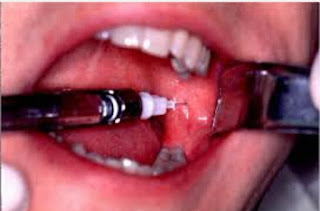Inferior Alveolar Nerve Block
# INFERIOR ALVEOLAR NERVE BLOCK
* Anatomical Landmarks of Inferior alveolar nerve block:
• Mucobuccal fold
• Anterior border of Mandibular ramus
• External oblique ridge
• Internal oblique ridge
• Retromolar triangle
• Pterygomandibular ligament
• Buccal sucking pad
• Pterygomandibular space
* Nerves Anesthetized by Inferior alveolar nerve block:
• Inferior Alveolar Nerve and its Sub-divisions :
Mental Nerve
Incisive Nerve
Lingual Nerve
Long buccal Nerve
* Areas Anesthetized by Inferior alveolar nerve block:
- Mandibular teeth to midline
- body of mandible
- Buccal mucoperiosteum and mucous membrane anterior to mandibular first molar
- Lingual soft tissues and periosteum
- Anterior two-third of tongue and floor of oral cavity
* Note: To anesthetize the soft tissue posterior to the 1st molar Long Buccal nerve should
be anesthetized.
* Amount of LA injected :- 1.8 ml
* Direct Injection Technique used for Inferior Alveolar Nerve Block :-
* Needle position :-
- 1st position : Inferior alveolar nerve is anaethetized from opposite side.
- 2nd position : lingual nerve is anaesthetized from same side.
- 3rd position : long buccal nerve is anaesthetized seperate.
* patient position :-
- patient is seated in supine or semi supine position with mandibular plane is parallel to the
floor.
* procedure :-
- with the index finger or thumb of the left hand palpate the external oblique ridge and move
posteriorly till the coronoid notch is contacted.
- place the index finger or thumb behind the mandible extraorally to access the width of
mandible.
- A 25 gauge needla is inserted from the opposite side parallel to the mandibular plane
bisecting the thumb or index finger up to half of the distance between palpating finger
intraorally and the finger behind the ramus of the mandible extraorally until the needle is
contacts the bone.
- After a negative aspiration, 1.5 ml of L.A injected slowly.
- needle is withdrawn about half inserted depth and 0.6 ml of L.A is injected for anaesthetize
a lingual nerve.
- Needle is inserted at 45° angle to the body of mandible just distal to the most posterior
tooth.
* The signs and symptoms of an inferior alveolar block are:
- Tingling and numbness of the lower lip (however it is not an indication of depth of
anesthesia).
- Tingling and numbness of the tongue (see Lingual Nerve Block).
- No pain is felt during dental treatment.




Comments
Post a Comment